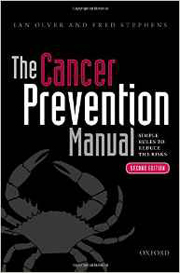13 October 2015
 The death rate from cancer could be reduced by one-third with simple lifestyle changes, is the message that UniSA’s Professor Ian Olver wants people to take away from a new book The Cancer Prevention Manual: Simple Rules to Reduce the Risks.
The death rate from cancer could be reduced by one-third with simple lifestyle changes, is the message that UniSA’s Professor Ian Olver wants people to take away from a new book The Cancer Prevention Manual: Simple Rules to Reduce the Risks.
Co-written by Prof Olver, the book is an updated version of the first edition from 16 years ago and now includes new information about advancements in cancer prevention and early detection.
Prof Olver, Director of UniSA’s Sansom Institute for Health Research, says many people are aware that smoking and sun exposure cause cancer but do not connect obesity, diet and exercise as risk factors for cancer, particularly common cancers like breast and bowel cancer.
“The main lifestyle changes are to stop smoking, eat a healthy diet, reduce alcohol consumption, exercise regularly, and protect yourself from the sun when it is intense enough to cause sunburn such as in the middle of the day during summer,” Prof Olver says.
“Often diet and exercise are associated with heart disease or diabetes rather than being a modifiable risk factor for cancer.
“There are so many myths and untruths out there about cancer. People love to argue over whether hair dye or underarm deodorants cause cancer when by far the greatest gains are made by simple lifestyle factors.
“Although it doesn’t sound spectacular, this will prevent far more cancers than by using any other strategies.”
Prof Olver hopes that in another 16 years, we will know far more about what triggers cancers and be able to be more specific about identifying people at high risk, from their genetic profiles.
“In 16 years we will be able to screen for more cancers,” Prof Olver says.
“We may well have developed anti-cancer vaccines to help prevent cancer – in addition to the antiviral vaccines which we use today to prevent viral associated cancer like cervix and liver.
“As a cancer researcher and doctor, I still find that many people seem to think of cancer as one disease where you can could find one cure.
“In essence, it is a couple of hundred diseases which have some common characteristics but which will require multiple treatment strategies.”
Published by Oxford University Press, and co-written with Fred Stephens, Emeritus Professor and Former Head of the Department of Surgery at The University of Sydney, the book is now available.
Contact for interview: Professor Ian Olver email Ian.Olver@unisa.edu.au




